JF Ptak Science Books LLC Post 903
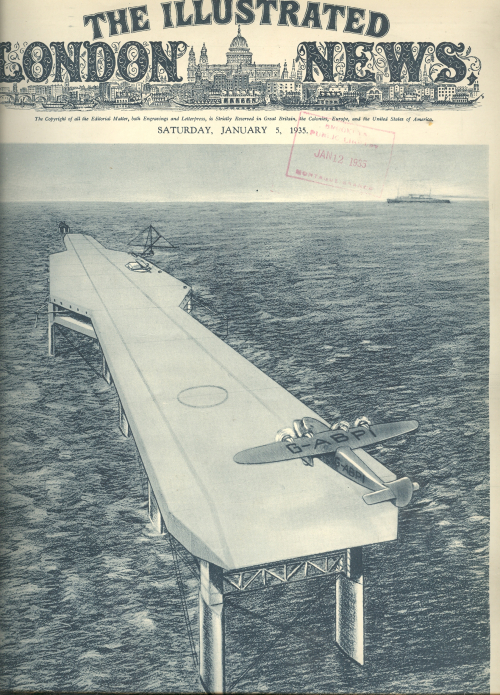
An even worse idea appeared in the pages of Science and Mechanics in 1936:
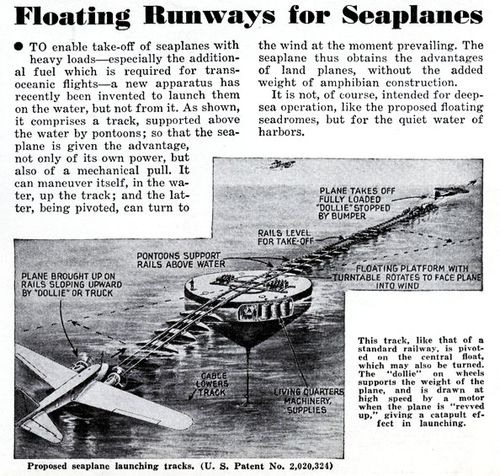
Notes:
Continue reading "Ocean-Crossing Floating Airports Across the Atlantic, 1935" »

JF Ptak Science Books LLC Post 903


Continue reading "Ocean-Crossing Floating Airports Across the Atlantic, 1935" »
Posted by John F. Ptak in Aviation & flight, Bad Ideas, Technology, History of | Permalink | Comments (0) | TrackBack (0)
JF Ptak Science Books LLC Post 899
The Babel-like tower pictured below is a still from the movie Things to Come (1936), an adaptation of H.G. Wells' The Shape of Tings to Come (1931). (Wells' himself wrote the screenplay a few years before the movie appeared.) The story is a history of the period from 1936 to 2054, including a devastating war that begins in December 1940 (complete with major air assault, poison gases and so on), followed by plague and destruction for another forty years, after which there is a confrontation between two classes of remaining humans, with big doses of New World Order, Technocracy, Fascism and glimmers of hope of science and technology saving the future. There's a lot that happens in the story, but the part I'm most interested in comes towards the end of the film and depicts a space gun for launching a massive capsules to the Moon--in this case, a capsule containing two "starred-crossed lovers".
We are told that the launching apparatus--the "gun"--is 1500 feet tall, which iterates out to a 750' base and which also makes the capsule about 75'. That's impossibly massive firepower. (Don't forget that somebody had to construct the 1700' tower next to the gun that lifted the capsule into position, for some reason lowering the thing down the barrel.)
In the history of big guns, this would be about the most massive ever constructed in the sci fi world so far as I can tell. In the real world, the Kaiser Wilhelm gun (or "Paris Gun", the Kaiser Wilhelm Geshutz) was a long-barreled, light shelled monster: its 92' long barrel (plus a 20' extension) launched a 94kg shell about 130 km, reaching a maximum height of 40km (about 25 miles) high. For all of its mass (the gun weighed 256 tons without the railway cars) the shell that it fired didn't weight much at all....though the shell did reach an extreme height. (Ironically, the gun was built for attacking the deepest of the deep bunkers of the fortresses along the Maginot Line; it was never needed for that, as the Maginot Line was simply left behind in the Nazi assault on France.)
The Schwerer Gustav was a 1350 ton beast which fired a 14,000 pound shell (!) about 20 miles. A little later came the Nazi V-3 (the lesser known of the V-weapons), the Vergeltungsewaffe 3, a 130 metre (!) long, 150mm gun built along the side of a hill, launching a 140 kg shell. The Iraqi Big Babylon gun was sort of like this one, though never built--it was to have a 500' barrel and would be supported by a hillside.
Getting back to the unfortunate Well's space gun: this thing was supposed to fire a 75' capsule which must've weighed in excess of 10,000 pounds (easy, what with supply and fuels and so on, plus the structural weight) straight up (!!) and somehow reach escape velocity of 11.2 km/s, piercing the exosphere some 400 miles high or thereabouts (or 1.5 orders of magnitude higher than the Paris Gun). I cannot intuitively imagine the tremendous explosion necessary to achieve this goal, although it could be figured out pretty easily. Back of the napkin figuring tells me that the speed of the capsule exiting the gun's barrel would place the occupants in the vicinity of something like 450Gs--that's more than ten times the lethal amount of force that a human can withstand. I'm not sure what happens to a person at 450Gs--I do know that it wouldn't be pretty. Anyway, none of this part of the space travel section of the movie wasn't pretty....except for the props, which I like, and which can be seen in the clip below.
Overall I think that this would make a lovely physics problem for discussion in a high school classroom.
Posted by John F. Ptak in Bad Ideas, Future, History of the, History of the Future, Technology, History of | Permalink | Comments (4) | TrackBack (0)
Tags: Future, H.G. Wells, History of the Future, Paris Gun, Space Gun. V3, Wells
JF Ptak Science Books LLC Post 898
(This is a
continuation of the Invasion of

Lesser
known are the
This
two-page spread (all that I have of a longer article) appeared in Fortune
Magazine for September 1935. It was undoubtedly generated
by a number of causes, not the least of which was the rearming of Nazi Germany (referred
to in this article as a ‘miracle”), which could theoretically cause some amount
of concern in semi-fortress
Basically the plan seems to call for a standing, ready army of specialist forces that were agile and highly trained, a large network, of anti-aircraft batteries and detection areas, and of course a large buildup of the Army Air Force. All of this of course cost money, and almost all o fit would’ve been directed towards MacArthur and his subordinates. (It is interesting and odd to note that the Fortune article notes that three of the top four major general assistants to MacArthur were Irish (“see the four big shots…with three Irish names”).)
[Due to difficulties in the size of this map I have to present it in three sections, but I’m sure that the overall flavor will be maintained.]
The most prominent feature (besides the black invasion routes) are the terribly antiquated (even for 1936?) depictions of coastal defense canons. Perhaps this was disingenuous to include them with such flair, what with the main point of the article lending itself towards air invasion, but there they are, protecting the American coastline from a ripping adventure from the sea.
But
as we can see the successful invasion routes are coming from odd places—from Alaska,
Canada, the Caribbean) against which the U.S. seemingly had no defense. This was especially true in the Pacific
Northwest (“here defense system is weak”) where
The
southwestern and southern
The
attack on
In
all of this I see that the industrial northeast is left alone, save for a “feint”
attack to dislodge resources and attention away from the movement against the
No
attacker is named in what I own of this article, and there is a very curious
absence of any threat coming from the already-warring
Taking
all sorts and manner of considerations into account, this is just simply a
miserable attempt to reckon what the future might bring to
JF Ptak Science Books LLC Post 896
Tonight’s inspiration comes from one of my daughter Tess’ bedtime stories, Dr. Seuss’ Oh, the Thinks you can Think—particularly one of the fantastic illustrations, this one showing a swimming pool balloon. I’ve seen some interesting images of balloons and dirigibles taken as serious efforts that reminded me of that double-page spread by the good Doctor.
In
July, 1931 Konstantin Zilkowsky’s sheet metal dirigible appeared in Modern Mechanics (this image from the
fabulous Modern Mechanix.com website, cropped), looking a lot like the mountain
and its imagined whale looked like to Herman Melville at his Arrowhead
home.
This may have been the Omega end of bad ideas in the career of Zilkowsky, who is better known by the other spelling of his name, Konstantin Eduardovich Tsiolkovsky (1857-1835), a Russian misanthrope and space pioneering genius who wrote more than 500 works on rocketry and exploration including what is arguably the first tech word ever done in the field (in 1903, The Exploration of Cosmic Space by Means of Reaction Devices). Tsiolkovsky somehow lasted through purges and Stalinist tirades, while few of his colleagues did—many mysteriously disappeared, while others went to prison and disappeared there. (Stalin’s crude and insatiable blood lust, perhaps the worst of the century, knew no bounds, not even to the scientists who could conceivably hand him reigns of rocket/missile-propelled power.) Anyway, Tsiolkovsky’s dirigible was composed of a collapsible metal so that the aircraft could form its own hangar when “docked”. I don’t know where to begin with this one…
The
second (among many other possibilities) is the ship-balloon of Thaddeus Lowe
(1832-1913) One of Lowe’s great contributions in the
history of ballooning was providing aerial reconnaissance via (panoramic)
photographs to the Union army on Confederate army positions—particularly the
Rebel positions at Richmond (1864) and Fredericksburg (1862). (He had a wide
span of professional interests and wound up living the high life in
I'd vote for Dr. Seuss' work as the most logical.
Posted by John F. Ptak in Aviation & flight, Bad Ideas, Technology, History of | Permalink | Comments (10) | TrackBack (0)
Tags: Dr. Seuss, Thaddeus Lowe, Tsiolkovsky
JF Ptak Science Books LLC Post 895
Earlier in this blog I’ve written about underground horses
and horses in the air (Towards a History of Horses in Flight in the 19th Century),
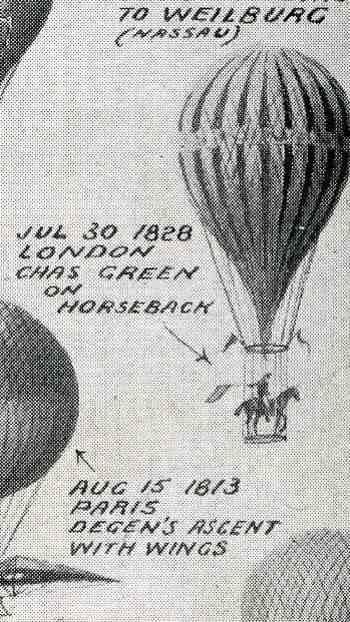 and
now to horses underwater. Or sort of.
This image from The Illustrated London News (5 April 1919) presents a
cross-section of a proposed Hudson River tunnel connecting the
and
now to horses underwater. Or sort of.
This image from The Illustrated London News (5 April 1919) presents a
cross-section of a proposed Hudson River tunnel connecting the
By that time there were no allowances for “slow horse-drawn trucks” that were shown in the 1919 cross section.
Notes:
1.”Progress
of the Great Railway Tunnels under the Hudson River between
And just for good measure, here's another bit: this time showing a horse at work in a tunnel under the Hudson:
Posted by John F. Ptak in Bad Ideas, Technology, History of | Permalink | Comments (0) | TrackBack (0)
DARPA has had a long-standing Christmas wish—a high-speed, durable, fast, agile tacticly-beautiful submersible aircraft. Such a thing has evidently been on the wish list of many agencies in many countries for many years.
I found the Royal Navy’s version of the DARPA wish in the 24 January 1920 issue of The Illustrated London News—the Tessaurian, a dreamable plane capable of long flight and long trips under the sea, as well as being able to float on the water and land on dry earth.
Even the modern Tessaurian has been evasive—certainly this 1920 version is nothing short of nothing. The craft just looks too bumpy to do well in any sort of fluid environment, air or liquid, the thickness of its skin (necessary for the heavy undersea pressures) looking just too heavy to lift off the ground. Of course the powertrain is suspect, and the retracted wings don’t look like they would do anything to glide the beast further underwater, assuming it got there (on purpose) to begin with. Even though I doubt that it could fly, it may be able to float a bit—I do think that it could sink like a champ.
And
so I reproduce these heady, unacknowledged and unclaimed drawings (“designed by
a leading aircraft company”), as I can’t find anything offhand online that
comes remotely close to its age and concept.
An
undergraduate (!) team (headed by Daniel B. Coltey et alia )at Auburn came up with
the following research paper earlier this year: “Conceptual Design of a
Submersible Tactical Insertion Aircraft” “This…senior design program…the
creation of a conceptual design for a submersible airplane is being undertaken
as a response in part to a challenge by the Defense Advanced Research Projects
Agency (DARPA).” The authors then state the checklist of DARPA’s needs: “The design is expected to be a clandestine,
coastal insertion vehicle with specific abilities of an airplane, surface ship,
and submarine vessel, which would greatly increase the tactical ability of the
Posted by John F. Ptak in Aviation & flight, Bad Ideas, Technology, History of | Permalink | Comments (3) | TrackBack (0)
Tags: submarine plane, Submersible aircraft
JF Ptak Science Books LLC Post 887
Thinking about the second day of Christmas brought me to the turtle dove, and then almost immediately to William Shakespeare, and on to H.W. Seager’s delightful Natural History in Shakespeare's Time being Extracts illustrative of the Subject as he knew it (London, 1896)1. Seager got to the point right away, quoting the turtle dove’s appearances in Winter’s Tale and Merry Wives before moving on to quote fabulous passages from Bartholomew de Glanvile and Albertus Magnus.
WINTER'S TALE, iv. 4
FLORIZEL:
“I think
you have
As
little skill to fear as I have purpose
To put
you to't. But, come; our dance, I pray:
Your
hand, my Perdita; so turtles pair
That
never mean to part.”
MERRY WIVES OF WINDSOR, iii. 3, 44.
Henry VI, Part IDuke of Burgundy:
“Myself, as far as I could well discern
For smoke and dusky vapours of the night,
Am sure I scared the Dauphin and his trull,
When arm in arm they both came swiftly running,
Like to a pair of loving turtle-doves
That could not live asunder day or night.
After that things are set in order here,
We'll follow them with all the power we have.”
“THE Turtle hath that name of the voice, and is a simple bird as the culvour, but is chaste, far unlike the culvour, and if he loseth his make [i.e., mate], he seeketh not com- pany of any other, but goeth alone, and hath mind of the fellowship that is lost, and groaneth alway, and loveth and chooseth solitary places, and flieth much company of men…”
Seager’s work was meant to be a polite background to the natural history of the time, and not an exhaustive treatise. He says in the preface: “this book presents in a convenient form for reference a collection of the quaint theories about Natural History accepted by Shakespeare and his contemporaries. The work is meant to be rather a sketch than an exhaustive treatise, otherwise it would fill many volumes. The plan of the book is to give some illustration of each word mentioned by Shakespeare when there is anything remarkable to be noted about it. The term " Natural History " has been taken in its widest sense, as including not only fauna but flora, as well as some precious stones…”
Posted by John F. Ptak in Bad Ideas, Blank and Empty Things; A History of | Permalink | Comments (0) | TrackBack (0)
Tags: Albertus Magnus, Bartholomew de Glanvile, Shakespeare, Turtle dove
JF Ptak Science Books LLC Post 880
I’m a sucker for cross sections, and this one has it all—nicely drawn, a glimpse into the possibilities of the future, and technoid removed from the realm of possibility. This article appears in Popular Science Monthly for June, 1934, and presents the possibility of extending downward into the earth for future city development. (as a matter of fact, the fabulous Modern Mechanix site has a similar story on display, asking the question “Are Skyscrapers Doomed?” for the same year, with the same engineers.) Well. It seems as though in this cross section that residences for people begin below the thirtieth floor, making living quarters starting at about 350’ down. The story goes that it would be possible to dig these cities up to about 6,000 feet into the earth, which of course is a long way down. Its difficult enough to drill an oil well hole to this depth; its difficult to imagine digging/outfitting/removing the earth from something—I’m not even sure what to call it—that was, potentially, thousands of feet deep and miles wide and long. That’s playing with figures hundreds of billions of cubic feet. Of construction. Underground. Well, I guess it wouldn't be necessarily underground--it could be an excavated hole that is a mile or two wide and across and down, which would make the hole itself several times larger than the largest whole ever dug by humans, which is the Bingham Canyon Mine, a pit slope mine that is about .5miles x 2.5 miles. And then construction would begin after which the remaineder would be covered by earth.
Anyway, it is a big hole and a lot of construction, the volume of it at the beginner phases of say a cubic mile would be equal to the volume of 25,000 Great Pyramids or 5,400 Empire State Buildings. It would be easier probably to build a vertical city in part of the Grand Canyon and then cover it up--that's an idea ou won't see in print too often.
Posted by John F. Ptak in Architecture and Building, Bad Ideas | Permalink | Comments (0) | TrackBack (0)
JF Ptak Science Books LLC Post 879 Blog Bookstore
Its funny how one can live the future in the present but not
see any part of that future’s future. Evidently
completely enveloped in the flying frenzy of the 1930’s, planners in
The
structure had almost everything going for it to be built in the bad category department: it was big, ugly, unnecessary, dangerous, a
hideous eyesore and an architectural atom bomb.
It also would have been almost antiquated by the time it was built,
serving as it did nothing but very small single-prop biplanes, virtually
useless by the time larger multi-engine propeller planes and jet aircraft would
appear just a decade and a half into the future. The thing was built high
enough (the top looking to be at least 300’ high, comparing it to the
Posted by John F. Ptak in Aviation & flight, Bad Ideas, Technology, History of | Permalink | Comments (0) | TrackBack (0)
Tags: airports, aviation history, bad ideas, Westminster Palace
JF Ptak Science Books LLC Post 878
I’ve been reading Nuremberg
Interviews (Knopf, 2004) by the American Leon Goldensohn, a psychiatrist who conducted interviews with
19 of the 24 “premier” Nazis brought to trial at
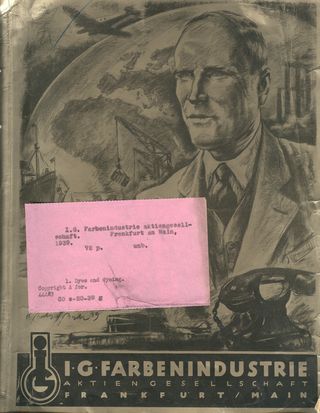
This is just one of a geographical dictionary of stories on the American/Nazi business connection and the financing of Hitler. It is a long and winding mass of roads, none of which is particularly pretty, many of which lead straight home, again. Henry Ford was impossibly ugly in all of this, a moral stain. But there were many like him as well.
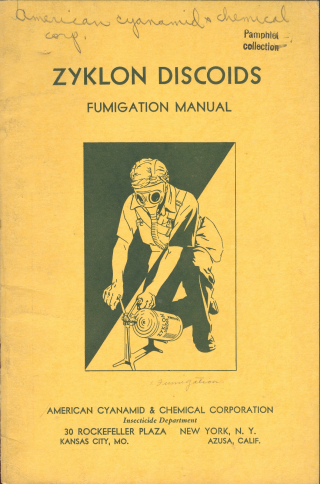
In the appalling history of the gas chambers, it was almost by accident that Zyklon-B came to be used to exterminate human beings. Its function to that time was to exterminate bug pests, but experimentation showed that it worked lethally upon humans. Monumental amounts of Zyklon-B were sent to the extermination camps, all without question. Dr. Fritz ter Meer, one of the directors of Farben and who knew exactly what the vast amounts of Zyklon-B was being used for, was tried at Nuremberg and sentenced to seven years in prison for genocide and crimes against humanity, though he was released after four years after the intervention of U.S. High Commissioner for Germany J.J. McCloy. (It was McCloy again, working with Standard Oil and the Rockefellers, who ensured that the massive Farben works at Frankfurt was taken off lists of American bombing targets in 1943 and 1944.) ter Meer returned to work for Farben after his imprisonment—though it wasn’t the old Farben anymore, the company having been slightly effaced, broken into several constituent elements. Ter Meer’s section of Farben was Bayer, as in Bayer aspirin, where he served as Chairman from 1952 to 1961. {Image below: political meeting at IG Farben.]
Dr. Fritz ter Meer, a director of IG Farben who was directly involved in developing the nerve gas, Zyklon-B, which killed millions of Jews, was sentenced to seven years in prison but was released after four years through the intervention of Rockefeller and J.J. McCloy, then U.S. High Commissioner for Germany. An unrepentant Fritz ter Meer, guilty of genocide and crimes against humanity, returned to work in Bayer where he served as Chairman for more than 10 years, until 1961.
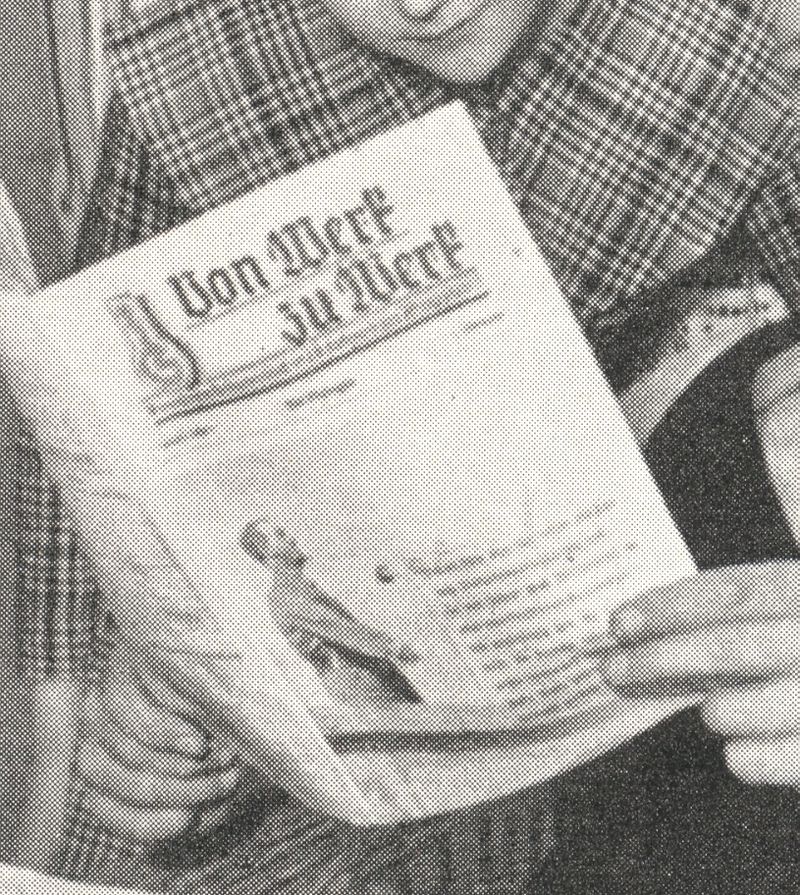 [Above: one of the many appearances of Hitler on the front page of Farben's newspaper, Von werk zu Werk.]
[Above: one of the many appearances of Hitler on the front page of Farben's newspaper, Von werk zu Werk.]
In all of this the survivor has been Zyklon-B itself: it is still in production in the Czech Republic by Draslovka Kolin (Kolin), and is now known as Uragan D2.
[Some vintage footage from the trials at Nuremberg.]
Posted by John F. Ptak in Bad Ideas, Militaria | Permalink | Comments (3) | TrackBack (0)
Tags: gas chamber, Holocaust, IG Farben Degesch, zyklon-b
JF Ptak Science Books LLC Post 877
This is a continuation of an earlier post on mapping the
invasion of
[It starts: LIFE
Magazine issued a wake-up call of sorts to its readership in their 2 March 1942
issue. I say “of sorts” because even though this hard article (entitled
“Now the U.S. Must Fight for Its Life”) must have sorely sobered some of its
readers, it started on page 15, following big ads for Listerine, Matrix
(women’s shoes, Bell Telephone, Modess, Clapp’s Baby Food, Dot Snap Fasteners,
Goodrich Tires, White Horse Scotch, Pompeian Massage (for shaving), Jack
Benny/Carole Lombard’s “To Be or Not To Be”, Colgate, Yardley powder and
Mimeograph, and a few interspersed puff pieces—and a Ginger Rogers cover
photo. But once LIFE paid its bills, the article got right to business,
responding to a February article by sci-fi/novelist Philip Wylie on the possibilities
of the
This image shows Japanese mountain troops rounding up the
locals after their successful attack on
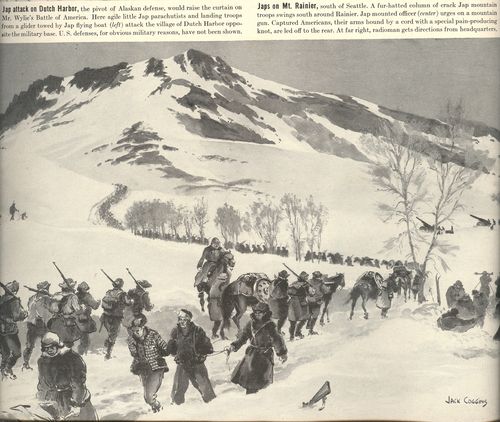 The petroleum culture is under attack here in southern
The petroleum culture is under attack here in southern
These Heinkel-177’s are bombing an unnamed East Coast war production
plant, crossing the ocean straight from
I’d say that this article might well have established a new
fear-line in the minds of many of LIFE’s
millions of readers, introducing them to the possibility of mainline attack
just a few short months following
Posted by John F. Ptak in Aviation & flight, Bad Ideas, Future, History of the, Militaria | Permalink | Comments (6) | TrackBack (0)
I should've included this list in yesterday's post about a 1909 zeppelin tramway but it slipped my mind. Here then are most of the posts I've made on zeppelins, balloons and dirigibles, mostly having to do with unusual deep-thought applications of their soon-to-be-replaced technologies.
I like the History of Horses in Flight the most...
Towards a History of Horses in Flight in the 19th C (here)
Balloon Bridges and 600-Foot-Long Airships (here)
Escape Pods for Women Balloonists, 1820: the Fabulous "Minerve" Balloon (here)
History of the Future: Electric Balloons, Tethered Eagles and an 18th century Space Station (here)
Zeppelin paper Model 1924 (here)
Advanced Sci-Fi Dirigible Notion, 1909 (here)
Vision: Looking Straight Up, Down, Across and Through--1525-1905 (here)
Posted by John F. Ptak in Aviation & flight, Bad Ideas, Technology, History of | Permalink | Comments (0) | TrackBack (0)
Tags: balloon, dirigible, flight, history of aviation, zeppelin
JF Ptak Science Books LLC Post 875
Here’s a highly-flammable, closely-space and
heavy-but-flimsy scenario just waiting for its first monstrous mishap.
This image is from the wonderful website of Alejandro Polanco Masa’s Tecnologia Obosleta, dedicated to antiquarian, paleofuturistic and non-existent technologies. It comes from the December 1909 issue of Scientific American, and according to the article was an “impracticable mode of transit” envisioned by an unnamed German engineer. It was a rigid structure airship--which means that it received its shape from a hard internal frame covered by a skin, rather than a balloon or dirigible, whose shapes are almost entirely dictated by a gas filling out their envelope—and looked a lot like Count von Zeppelin’s new (1899) LZ-1 flying machine. No doubt the engineer with this land-based system had been caught in the considerable zeppelin fever which existed at the time. It stretched the engineering boundaries of the possible more than just a little, and looks to me like a disaster that should’ve happened almost immediately. It was also supposed to speed along at 125 mph, by who knows what means. Seems to me that there would be fifty towers per mile for a huge flammable Zep carrying not many people--it doesn't seem to make sense to me, particualrly when railroads would've done a better job safer and cheaper moving more people and, of course, the freight that these things just couldn't carry. The SciAmerican ended: “There are engineering as well as financial objections to this scheme.”
See HERE for other posts on balloons, dirigibles and zeps.One of my favorite categories/threads in this blog is the sublime-mundane pamphlet title.
Envelope Facts, Notes on Reading Aloud, Saturn Has Rings, Know Your Groceries, Zipper Repair, Flagpole Painting,The Fine Art of Squeezing, Thirst and two dozen others have bobbed to the surface here like antique lobster pots finding their way to the daylight after 50 years of the big dark cold—at this point, no one cares what’s inside, sort of-- just the very story and appearance is good enough.

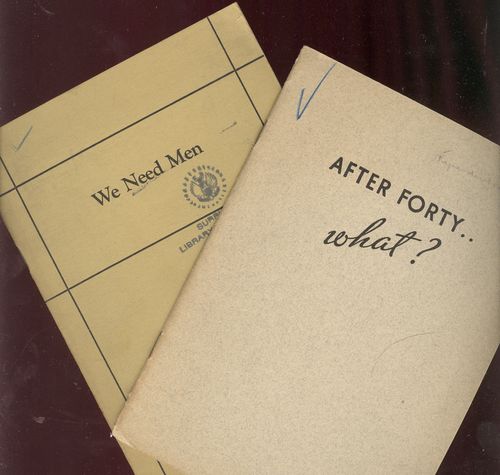
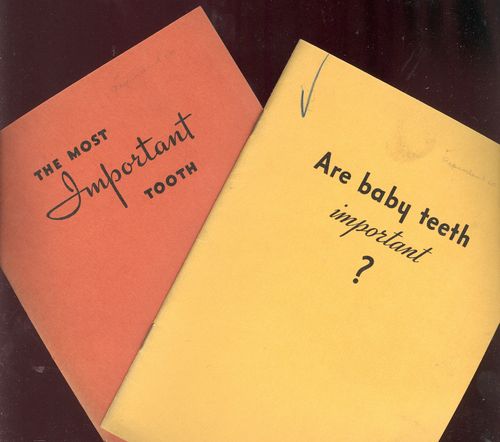
Some other examples: here, here and here.
[Where do these odd things come from?]
Posted by John F. Ptak in Bad Ideas, Fantastic Titles | Permalink | Comments (0) | TrackBack (0)
JF Ptak Science Books LLC Post 871
The Maxim Gorky (Gorkii, ANT-20) was the largest plane of its time, a craft intended to show the world of the vast technical prowess of the Soviet Union. There is now doubt that the plane was huge--112’ long, 22’ high, with a wingspan of 206’ (and 5,200 sq ft surface area), and weighed in at 59 tons—and was indeed the largest plane in the world.

The reality of the craft was closer to its rear wheel, which was manufactured of metal and filled with cement.
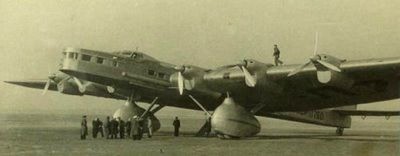
The plane was built by TsAGI was big—it was also ponderous, pretentious, terrifically slow (cursing speed of 141 mph and top speed of 171), and just a beast. It was built very quickly, and it showed; it offered nothing new so far as design is concerned, being a cobbled montage of existing blueprints. It did set world records for lifting stuff, but beyond that, it was a half-dead behemoth..
Construction on the Gorky began in the midst of the Great Famine, a murderous Stalinist rampage which the result of planning and control on the collectives that killed 7-8 million Russians and Ukranians1 and which also destroyed the Ukrainian resistance, and which was also one of the most disgusting of the 20th century genocides…but there are so many to choose from. (See Robert Conquest, the Harvest of Sorrow2).
The Gorky was a magnificent nothing. It was dedicated, finally, to a serve as a propaganda tool for the inglorious voice of Joseph Stalin, fitted into service with a movie/film, theater, print shop, photo lab, press room, radio station, and other creature comforts. The Gorky, the “Victory Over the Air”, met its end 18 May 1935 in a crash with two other Soviet planes during maneuvers, crashing near Sokol Station, killing everyone on board and another 35 on the ground.
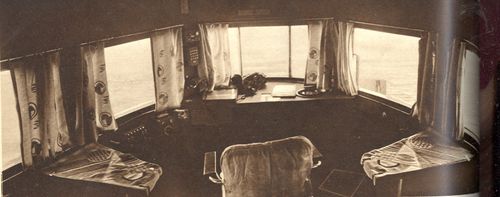
I’ve included photos of the interior of the plane which illustrated and article in the 19 January 1935 issue of The Illustrated London News. I could find no other pictures of the inside of the plane online.
{Photos in the CONTINUED READING section.)
Notes:
See:
http://www.dictatorshipoftheair.com/wp-content/themes/content/excerpt2.pdf
http://dictatorshipoftheair.com/2007/01/04/the-ant-20-maxim-gorky-in-flight/
The Great Terror
1.The Holodomor (the Ukrainian Famine of 1932-1933). http://en.wikipedia.org/wiki/Holodomor
2.Robert Conquest The Great Terror: Stalin's Purge of the Thirties (1968) , The Nation Killers: The Soviet Deportation of Nationalities (1970) Lenin (1972) , Kolyma: The Arctic Death Camps (1978) , Inside Stalin's Secret Police: NKVD Politics, 1936-1939 (1985) ,The Harvest of Sorrow: Soviet Collectivization and the Terror-Famine (1986) , Tyrants and Typewriters: Communiques in the Struggle for Truth (1989) , Stalin and the Kirov Murder (1989) ,The Great Terror: A Reassessment (1990).
Continue reading "Joseph Stalin’s Flying Circus: the Maxim Gorky Aircraft, 1934" »
Posted by John F. Ptak in Aviation & flight, Bad Ideas, Militaria, Technology, History of | Permalink | Comments (3)
Tags: aviation history, Great Famine, Maxim Gorky, Propaganda, SOviet Purges, Soviet Union